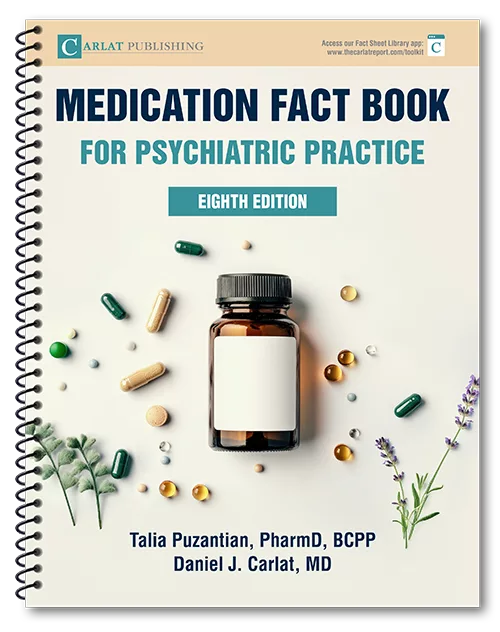Home » Suboxone: A Primer
Suboxone: A Primer
June 1, 2006
From The Carlat Psychiatry Report
Suboxone (buprenorphine/naloxone) was approved by the FDA on October 8, 2002 for the treatment of opioid addiction.
This has been heralded as a landmark in psychiatry (see “Anecdotes from the Field” in this issue), which is difficult to fully comprehend for those of us who do not specialize in the treatment of addictions. So a little background on opiate treatment is helpful.
Until the approval of Suboxone, we had two options for treating opioid addiction— naltrexone and methadone.
Naltrexone is a straight opiate blocker, and, analoguous to Antabuse (disulfiram) in alcoholism, only works for a highly motivated addict, since it stops providing protection for those who do not take it.
Methadone has numerous problems. One is access, since it can only be given at specialized licensed clinics. The other is that it is essentially a straight substitution treatment, an oral version of heroin. Like heroin, methadone makes users feel high, and many addicts continue to use illicit opioids while they are in methadone treatment.
There was clearly a crying need for an alternative.
The main ingredient in Suboxone is the opiate buprenorphine, a medication that has been available as an injectable narcotic (brand name Buprenex) since 1981. Buprenorphine is a partial opioid agonist, meaning that it occupies the opiate receptors but doesn’t cause quite the same intensity of analgesia (or “high”) as full opiate agonists such as oxycontin or methadone. The other ingredient in Suboxone is naloxone, which is simply the injectable version of naltrexone. Suboxone is composed of buprenorphine and naloxone in a ratio of 4:1. Why, you might ask, would you combine an opiate antagonist with an opiate agonist? This is a neat pharmacological trick to prevent Suboxone from being ground up and shot intravenously. When taken as directed (sublingually), the buprenorphine works but naloxone has only a limited effect. However, when injected, naloxone comes alive, causing immediate and painful withdrawal symptoms in patients addicted to opiates.
Suboxone comes in two dosage strengths: 2 mg and 8 mg. Starting patients on it is tricky, because if a patient already has opiates on board (and active opiate abusers are candidates for Suboxone), adding Suboxone will have the effect of precipitating withdrawal, because buprenorphine shoves other opiates off their receptors, and since it is only a partial opiate agonist, those receptors are “hungry” for something stronger. For this reason, patients must be allowed to go into a mild to moderate state of opiate withdrawal before their first Suboxone dose. Thus begins the 2 to 3 day “induction” period, during which you determine the exact dose needed for eventually maintaining patients in a comfortable, non-craving, state. The typical target dose in most patients is about 16 mg QD SL, which may be split BID or QID depending on the patient.
Unlike with methadone, many patients taking Suboxone can tolerate discontinuing it by gradually decreasing the dose. After the last dose, some clinicians will prescribe a short course of naltrexone to aid patients in maintaining abstinence.
Becoming licensed to prescribe Suboxone requires jumping through some hoops, but not too many. The training course costs $100-$150, lasts 8 hours and can be done in person or online; you can find a course near you at www.docoptin.com/Physician/Default.aspx.
TCPR Verdict:
Suboxone: Yes, it is a breakthrough!
General PsychiatryThis has been heralded as a landmark in psychiatry (see “Anecdotes from the Field” in this issue), which is difficult to fully comprehend for those of us who do not specialize in the treatment of addictions. So a little background on opiate treatment is helpful.
Until the approval of Suboxone, we had two options for treating opioid addiction— naltrexone and methadone.
Naltrexone is a straight opiate blocker, and, analoguous to Antabuse (disulfiram) in alcoholism, only works for a highly motivated addict, since it stops providing protection for those who do not take it.
Methadone has numerous problems. One is access, since it can only be given at specialized licensed clinics. The other is that it is essentially a straight substitution treatment, an oral version of heroin. Like heroin, methadone makes users feel high, and many addicts continue to use illicit opioids while they are in methadone treatment.
There was clearly a crying need for an alternative.
The main ingredient in Suboxone is the opiate buprenorphine, a medication that has been available as an injectable narcotic (brand name Buprenex) since 1981. Buprenorphine is a partial opioid agonist, meaning that it occupies the opiate receptors but doesn’t cause quite the same intensity of analgesia (or “high”) as full opiate agonists such as oxycontin or methadone. The other ingredient in Suboxone is naloxone, which is simply the injectable version of naltrexone. Suboxone is composed of buprenorphine and naloxone in a ratio of 4:1. Why, you might ask, would you combine an opiate antagonist with an opiate agonist? This is a neat pharmacological trick to prevent Suboxone from being ground up and shot intravenously. When taken as directed (sublingually), the buprenorphine works but naloxone has only a limited effect. However, when injected, naloxone comes alive, causing immediate and painful withdrawal symptoms in patients addicted to opiates.
Suboxone comes in two dosage strengths: 2 mg and 8 mg. Starting patients on it is tricky, because if a patient already has opiates on board (and active opiate abusers are candidates for Suboxone), adding Suboxone will have the effect of precipitating withdrawal, because buprenorphine shoves other opiates off their receptors, and since it is only a partial opiate agonist, those receptors are “hungry” for something stronger. For this reason, patients must be allowed to go into a mild to moderate state of opiate withdrawal before their first Suboxone dose. Thus begins the 2 to 3 day “induction” period, during which you determine the exact dose needed for eventually maintaining patients in a comfortable, non-craving, state. The typical target dose in most patients is about 16 mg QD SL, which may be split BID or QID depending on the patient.
Unlike with methadone, many patients taking Suboxone can tolerate discontinuing it by gradually decreasing the dose. After the last dose, some clinicians will prescribe a short course of naltrexone to aid patients in maintaining abstinence.
Becoming licensed to prescribe Suboxone requires jumping through some hoops, but not too many. The training course costs $100-$150, lasts 8 hours and can be done in person or online; you can find a course near you at www.docoptin.com/Physician/Default.aspx.
TCPR Verdict:
Suboxone: Yes, it is a breakthrough!
KEYWORDS substance-abuse
Issue Date: June 1, 2006
Table Of Contents
Recommended
Newsletters
Please see our Terms and Conditions, Privacy Policy, Subscription Agreement, Use of Cookies, and Hardware/Software Requirements to view our website.
© 2026 Carlat Publishing, LLC and Affiliates, All Rights Reserved.


_-The-Breakthrough-Antipsychotic-That-Could-Change-Everything.webp?t=1729528747)



